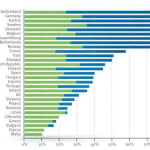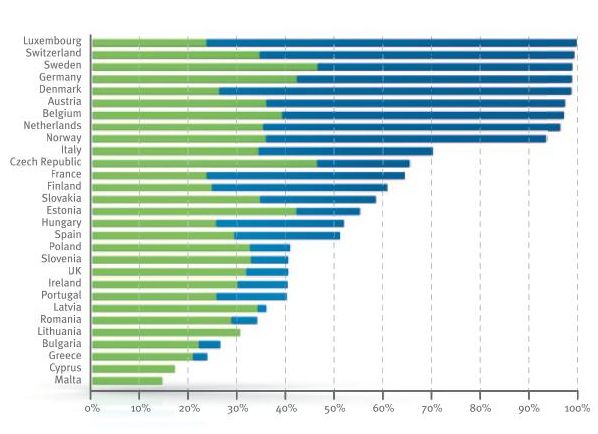 To capture the full value of plastics waste, it is necessary to combine different waste management options. Solutions vary from one country to another depending on the infrastructure, the national waste management strategy and the available technologies.
To capture the full value of plastics waste, it is necessary to combine different waste management options. Solutions vary from one country to another depending on the infrastructure, the national waste management strategy and the available technologies.Part of the solution to plastics waste management lies in the acceptance by society that resources should be used efficiently and that plastics waste is considered as a valuable resource that should not be wasted in landfill. It is no coincidence that the top nine performing countries in Figure 12 all have tight restrictions on landfilling. If extended to the rest of Europe such restrictions will create strong drivers to increase recycling and recovery levels towards 100%.
Any strategy aiming for improving waste management should combine both recycling and energy recovery. Plastic waste products which are not suitable for recycling, due to environmental and economic reasons, should be used as a complementary fuel in order to recover their embedded energy.
Figure 1 below shows that whilst recycling performance ranges mostly between 15 to 30% inmost countries, energy recovery levels vary between 0 and 75%. Countries which currently landfill valuable end-of-life material have an opportunity to reduce their climate footprint, address their energy deficit and use resources more efficiently through quickly expanding their energy-from-waste and recycling networks.
Overall slow progress has been achieved in capturing the value from plastics waste. The increase in recycling and recovery rate is approximately 5% per year. Many EU member states need to pursue greater efforts in order to divert their plastics from landfills by 2020.
In Figure 2 we can see how the increase in recycling and energy recovery rate between 2006 and 2010 varies between EU Member States. The biggest improvement in recovery rate has been achieved in Estonia with 29%, followed by Finland at 27%. A number of countries have increased their recovery around 15%: Hungary, Slovakia, Germany, Czech Repulic, Norway and Lithuania.
Denmark, Switzerland, Malta, France and Sweden have improved their recovery rate by less than 5% but with a change from energy recovery to recycling in Denmark, Sweden and Switzerland where even in 2006 little plastics went to landfill.
Recycling and recovery rates for plastics packaging is higher, 66% compared to 58% for all plastics, reflecting the focused efforts over a longer period to develop recycling and recovery options. Recycling and energy recovery rates are similar for packaging (32 vs 33%) whilst energy recovery plays a bigger role for all plastics (24 vs 34%).(See Figure 3)
Total recovery rate by country - referred to post-consumer plastic waste. Recycling rate (green colour), Energy recovery rate (blue colour).

Change in total recovery rate by country - referred to post-consumer plastic waste. Recycling rate (green colour), Energy recovery rate (orange colour).

Total Recovery Rate by Country - referred to post-consumer packaging plastic waste. Recycling rate (green colour), Energy recovery rate (blue colour).





